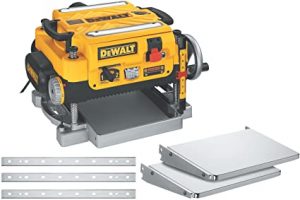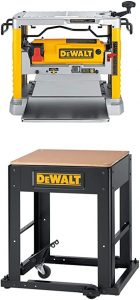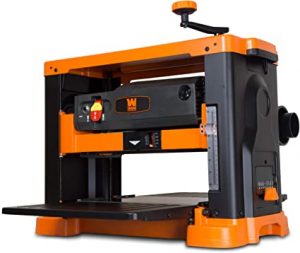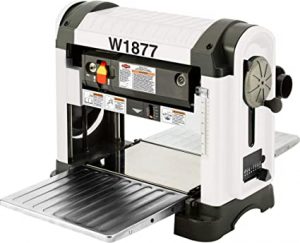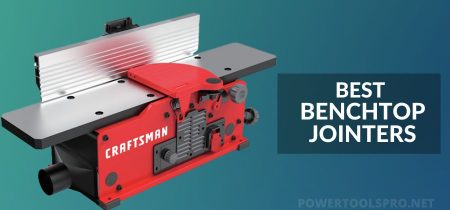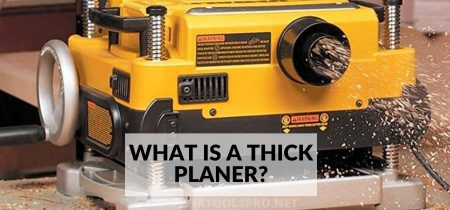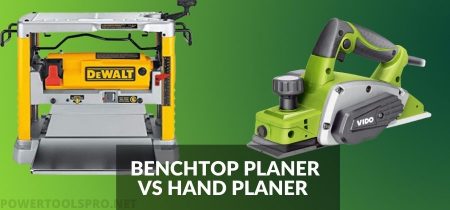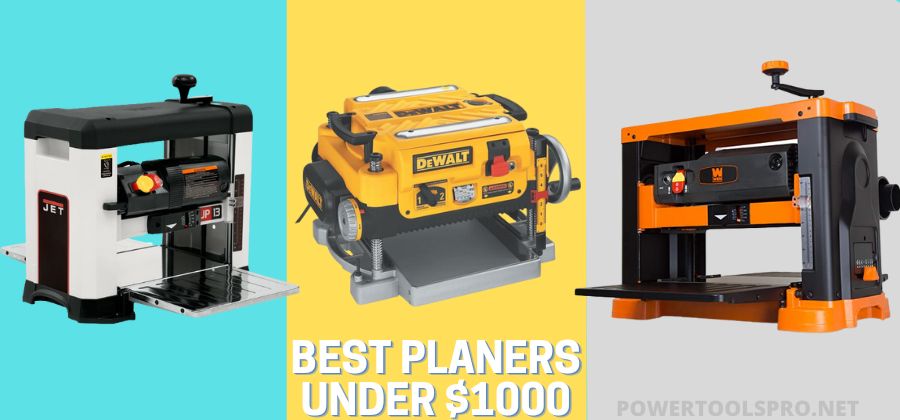
A benchtop planer is a specialized woodworking tool used to reduce the thickness of a wooden work piece. It is also known as a wood planer or thickness planer.
It is a sizable box-shaped power tool with moving blades within that remove minute amounts of the work piece’s surface to change the thickness.
In addition to having a constant thickness, they offer a smoother surface on various wood pieces after cutting, which is very helpful for creating multiple tasks like level tabletops, joinery, and others.
If you are looking for the best benchtop planner in your budget, then you should continue reading this article to find out more about these machines and some of the available best benchtop planers under $1000.
A thickness planer is a need for your workshop if you intend to work with rough-sawn lumber and create a spectacular item with smooth sides and uniform thickness.
Thickness planers perform these three crucial tasks in woodworking and construction
- Scraping down rough stock
- Making a board’s faces parallel
- Achieving a constant and precise thickness of the stock.
List of Best Benchtop Planer under 1000
We’ve researched some of the top benchtop thickness planers under $1000 to help you with your search
Top Thickness Planers under 1000 At a Glance:
- Dewalt Thickness Planer (DW735X)
- JET JWP-13BT
- DEWALT DW734
- Wen PL1303 with Extendable Table
- Shop Fox W1877
Dewalt Thickness Planer (DW735X)
Best Dewalt 13 inch Thickness Planer
SPECIFICATIONS
Power Source: Corded Electric | Voltage : 120240 Volts | Weight: 80 Lbs | Style: 2-Speed 13″ w/Feed Tables & Extra Blades | Base material: Metal | Warranty: 3 Years | Amazon Rating: 4.8 / 5 |
REASONS TO BUY
✓Incredibly quick benchtop planer
✓The warranty duration is really nice
REASONS TO AVOID
✗Better dust collection is possible.
✗Loud when in use
If you’ve ever purchased or searched for power tools, you’ve probably encountered Dewalt. Dewalt is a well-known company that produces a wide variety of excellent power equipment
It is our top pick for the best benchtop planers because of a few remarkable qualities. It is powered by a 15 amp motor that has a 20000 RPM maximum speed.
The Dewalt DW735 is able to reach a high cutter head speed of 10,000 RPM because of its high-speed motor. Additionally, it features two switching speeds that may be configured for either completing operation or dimensioning operations.
An automated carriage lock that aids in locking the cutter head in a position to avoid snipping at the ends of the boards is another feature of the Dewalt DW735X tabletop thickness planer.
To keep the cutter head clear of any obstructions that could slow the machine down, a fan-assisted dust ejection helps suck chips and sawdust off the cutter head and out of the machine.
A standout feature of the DW735X is its 19 3/4-inch cast aluminum base. In addition to providing a flat surface on which to run your materials, certain models can be twice as stiff. This lessens snipe and produces far more reliable outcomes. The DW375X also includes additional in-feed and out-feed table wings.
This is one of the best Dewalt 13-inch Thickness Planer undoubtedly.
Here is a quick look at all the features and qualities present in this remarkable planer.
- Motor 15 amps
- 10000 RPM cutter head speed and 20,000 RPM motor speed
- Two-speed adjustable range
- Uses three-knife cutter blades.
- Integrated dust-removal system
- 13-inch workpiece with a 1/8-inch depth of cut
- Three-year warranty
JET JWP-13BT
Best Value Benchtop Planer
SPECIFICATIONS
Power Source: AC source | Voltage: 120 volts | Weight: 75 Lbs | Style: Benchtop planer style | Base material: Alloy Steel, Cast Iron | Warranty: 3-Year | Amazon Rating: 4.2 / 5 |
REASONS TO BUY
✓A cutter head with a helical design operates more quietly and provides superior cuts.
✓The planer is strong and well-built.
✓For a better finish or to remove more material from the workpiece, the feed rate
✓Cutter head inserts are less expensive and simpler to replace.
✓13 inches more breadth is now possible.
✓Excellent dust collection
REASONS TO AVOID
✗In comparison to the competition, it is fairly expensive.
The JWP-13BT, a new 13″ helical-style benchtop planer from Jet is the best value benchtop planer under 1000 with 26 separate cutters arranged in 6 rows.
If worn out or damaged, each quick-change knife insert can be rotated or replaced as necessary.
The main benefit of helical-style and knife insert planer cutter heads is that users typically don’t need to replace or sharpen complete knife blades if there is a chip or other damage in only one area.
Planers with helical designs frequently have quieter operations than those with straight-knife cutter heads.
There should still be some advantages over straight knife blades even though the Jet planer doesn’t appear to have a full helical cutter head.
Six rows of cutters in Jet’s cutter head aim to make two full cutting passes. Jet provides its cutter head with rectangular inserts rather than square ones, and each is secured to the cutter head with two machine screws.
Here is a quick look at all the features and qualities present in this remarkable planer.
- Adjustable depth stop for repeatable, steady cuts
- Folding in feed/out feed tables that can be adjusted to level to a bed and take up less room when stacked
- 18 or 26 fpm dual in feed speed controls increase the effectiveness of cuts in various types of wood
- Dust Port connects to the dust management system and aids in maintaining shop cleanliness.
- Maximum cut depth of 1/8″, maximum depth of 6″, and maximum breadth of 13″
- Precisely crafted Boards are kept flat and snipe is decreased with the help of a cast-iron bed and steel cover
DEWALT DW734
Best Benchtop Planer for Professionals
SPECIFICATIONS
Power Source: Corded | voltage : 220 volts | Weight: 80 pounds | Style: W/ Knives | Base material: Steel | Warranty: Three-year limited warranty | Amazon Rating: 4.5/ 5 |
REASONS TO BUY
✓Three-blade cutter head;
✓Maximum cut depth of 1/8 inch;
✓Enduring design
✓Dependable manufacturer’s coverage
REASONS TO AVOID
✗Cost is greater than that of competing brands
✗Possesses just one running speed
According to its specs, the DeWalt DW734 Planer is a strong powerhouse. Because of this, it can effortlessly cut through hardwoods like oak.
That’s a start. Since that is the main objective of this instrument but there’s more to think about when you mix it with the outcomes. The three-knife cutter head makes waste-increasing, clean cuts without any snipe.
Accurate cutting and controlling board length are two challenges of using a planer. This problem is addressed by the extra-long in-feed and out-feed tables of the DeWalt DW734 planer.
It is simpler for a lone DIYer to handle the work safely due to its 33-inch length. The replaceable and reversible blades that further strengthen this feature were also well received.
The DeWalt benchtop thickness planer is powered by a 15 amp electric motor. This is a typical motor size, as may be shown by looking at the power tool market.
The 20,000 RPMs it can produce, translate into 10,000 RPMs on the cutting head. That top speed is achieved with no load. When you make the maximum cut from harder wood species, your top speed can decrease.
The fact that this wood planer has a three-knife cutter head should be emphasized. More cuts can be made per inch and a nicer first-pass finish can be achieved by using three blades as opposed to two. Additionally, it will extend blade longevity by up to 30%.
A constant feed rate of 26 feet per minute is offered by the rollers. 96 Cuts Per Inch are produced by combining that with the 10,000 RPMs of the cutter head (CPI). You’ll obtain a surface that needs less sanding and is reasonably smooth.
Here is a quick look at all the features and qualities present in this remarkable planer.
- Larger, deeper cuts in hardwoods can be made using a powerful 15.0 amp, 20,000 RPM motor.
- The 96 cuts per inch, 10,000 RPM three-knife cutter head offers one of the best finishes of any portable planer.
- Four-column carriage lock significantly reduces the movement that causes snipe
- Extra-long in feed and out feed tables provide 33-1/2″ of material support
- Material removal gauge and extra-large thickness scale deliver accurate cuts with every pass.
- Turret depth stop allows users to easily return to their most frequently used depths.
- Disposable, reversible knives deliver 30% more knife life and make knife change fast and easy.
For a shop looking to update or one that handles a lot of timber dimensioning, this product would be a fantastic choice. If you primarily utilize pre-dimensioned lumber, it might not be suitable.
DEWALT DW734 is considered as one of the best benchtop planer for professionals because you can remove up to 1/8 inch of wood every pass with this benchtop planer. It will take boards that are 6.0 inches thick and 12.5 inches broad
Wen PL1303 with Extendable Table
Best Benchtop Planers For The Money
SPECIFICATIONS
Power Source: Corded Electric | voltage : Not Found | Weight: 35 kg | Style: Benchtop | Base material: Wood | Warrenty: Two-year warranty | Amazon Rating: 4.5 / 5 |
REASONS TO BUY
✓The planer’s height can be easily changed.
✓Offers a respectable warranty timeframe
REASONS TO AVOID
✗Expensive item
✗Better dust collection is possible.
One of the most well-known companies, WEN produces a variety of power tools, and it has many happy customers. As a result, it ranks second on our list as one of the best Benchtop planers for the money.
Workpieces and planer boards up to 13 inches broad and 6 inches thick can easily be supported by this Wen PL 1303 corded electric planer’s 15A motor.
On the front of the planer, there is a material removal gauge that will show you how much material has been removed throughout each cycle.
Additionally, it is a rapid planer with a feed rate of 26 feet per minute and 30000 cuts per minute. It has a 13-inch, conventional 3-reversible SK5 blade design that makes it simple to use.
For an extraordinarily smooth finish, the WEN 13-Inch Benchtop Thickness Planer repurposes worn-out and rough wood.
Up to 30,000 cuts per minute are possible with the strong 15-amp motor’s 26 feet per minute feed rate. You can easily plane boards that are up to 13 inches broad and 6 inches thick.
Every pass can remove anywhere between 0 and 1/8 of an inch thanks to the convenient depth adjustment knob.
The workpiece’s 2.5-inch and 4-inch dust apertures remove chips and debris, and the depth stop presets assist you to avoid removing an excessive amount of material from the workpiece.
Additionally included in this set are height-adjustable in-feed and out-feed tables, which help to prevent snipes while additionally supporting your workpiece while planning. It is one of the best Benchtop planers for the money.
Here is a quick look at all the features and qualities present in this remarkable planer.
- Up to 6 inches thick and 13-inch wide planks
- At a feed rate of 26 feet per minute, a 15A motor produces 30,000 cuts per minute.
- Contains three 13-inch SK5 blades that are reversible (model BP133K)
- With each pass, change the cut depth from 0 to 1/8 of an inch.
Shop Fox W1877
Best Portable Benchtop Planer
SPECIFICATIONS
Power Source: Adapter | voltage : 120 V | Weight: 88 pounds | Style: Spiral‐Style | Base material: Stainless Steel | Warranty: 2 Year | Amazon Rating: 4.5 / 5 |
REASONS TO BUY
✓
REASONS TO AVOID
✗
The incredible 13-inch portable planer with a special repeat cut option. As a result, you may easily adjust the cutter head to one of six pre-set heights, ranging from 1/8 inch to 1-3/4 inch.
Additionally, the machine’s top has a handy thickness scale for monitoring your planning progress. Everything you would anticipate from a high-end portable planer, including an extension table that folds up for storage and transport, a cutter head height lock for constant production work, and a spiral-style cutter head with indexable inserts for smoother finishes. It is one of the best portable benchtop planers
Here is a quick look at all the features and qualities present in this remarkable planer.
- 2 HP, 120 volts, single phase, 15 amp motor
- 13 inches maximum stock width.
- 6 in. is the maximum stock thickness.
- 1/8 in. is the maximum cutting depth.
- Spiral-style cutter head with 26 two-sided index-able inserts.
- 10,000 RPM for the cutter head
- 26 FPM Feed Rate
- 13 x 33-1/4-inch table with extensions.
- Dust port size: 4 in. with accompanying 2 1/2 in. adapter
- Size: 30 x 34 x 20 inches.
- Size of the carbide insert 14mm x 14mm x 2mm.
Shopping Guide for Best Benchtop Planer Under 1000
Here is a quick overview of the main things to consider when buying a benchtop planer.
Self-indexing knives:
Self-indexing, double-edged knives are present in almost all straight-knife cutter head variants. (Setting knives that don’t self-index is difficult and time-consuming.)
Additionally, an automated cutter head lock is beneficial since it stops the head from rotating as you take out the bolts and knives.
Some portable planers are now available with (or as an option) segmented cutter heads, which are made up of 12-inch-thick segments that are each equipped with a high-speed steel insert cutter and have four cutting edges apiece.
The main benefit of this head is that if one or more cutters are damaged, you can easily replace them by rotating the afflicted inserts by a quarter-turn.
Gauges and stops:
A gauge that shows how much wood will be removed with each pass is found on many planers. These gauges help to stop overeating, which could lead to tear-out or deeper puncture.
We particularly appreciate the adjustable preset depth stops, which come in handy when planning various project sections to the same thickness and prohibit planning a board any thinner than the desired thickness.
You can immediately determine the height of the cutter head from the planer’s deck using wood planers that have built-in gauges. This measurement describes the thickness of a piece of wood after it has been planned.
You can lock in that measurement using a depth stop, then lift the cutter head and feed many boards through it while lowering it passes until you reach the appropriate thickness. It will not descend any further than your depth stop will permit.
Dust collection:
Using thickness planers produces a lot of dust. These machines rip off and spit out minuscule bits of wood, and after only a few boards, the floor beneath a thickness planer will resemble a kid’s sandbox.
To reduce mess, the best benchtop planers incorporate dust ports that connect to a shop vacuum or dust collection system.
In order to preserve the machine’s useable life and cutting speed, these collecting systems also do a good job of eliminating dust from the machine before it may gather at the cutter head.
Power:
The motor of a benchtop planer must have sufficient power to complete the task. Your individual project will determine how much is sufficient.
If you construct furniture or birdhouses out of softer woods like pine, cedar, and fir, for instance, a less potent motor in the 1 to 1 1/2 horsepower range would work well for you.
To remove a layer of material from the top of these materials, a thickness planer doesn’t require much power.
Cutting Capacity:
Cutting depth refers to how much material a wood planer can remove in one pass. Generally speaking, the more powerful the planer, the more material it can remove in one pass and the larger the depth of cut.
However, pieces of wood that are much thinner than the maximum capacity that the wood planer can handle (width-wise) may draw less on the motor, allowing the blades to remove more material accurately and smoothly than if the piece was very wide.
This planer will have a maximum capacity of 12 to 13 1/2 inches. Make sure to select a model with a little bit more capacity than you need, but keep in mind that larger machines cost more.
Blade Style:
There are two types of thickness planer blades: straight and spiral (or knives). Straight knives are similar to lengthy safety razors attached to the cutter head that may remove multiple layers of material in a single pass but produce unsatisfactory results.
Although spiral blades are more expensive than straight ones, they include numerous tiny knives that deliver reliable results.
Knives that spiral or helical operate extremely differently. Spiral cutter heads have numerous tiny blades offset from one another in a spiral around the cutter head rather than a single long straight blade. Results from spiral knife planers are more reliable than those from straight knife planers.
Conclusion
Every woodworking workshop needs a benchtop planer, and you should also have one in your garage as a useful piece of woodworking equipment. On the other hand, using a benchtop planer may do a lot of work that would otherwise take a lot of time and human labor. There are many different manufacturers that produce benchtop planers because they are a fairly common product on the market.
Making a choice from all of these possibilities is challenging due to the wide range. In order to assist you, we have listed the best benchtop planer under $1000 and written a buying guide
No planer is going to be perfect from every perspective. It will always have certain features and not others.
It all ultimately comes down to how much you’re willing to give up for something else. We hope you may find a tool that will make your work as a woodworker, do-it-yourselfer, or craftsman as simple and effective as possible.
Frequently Asked Questions
What can a thickness planer be used for?
A large machine called a tabletop thickness planer enables you to obtain uniform thickness on various work pieces so that you won’t have to stress about the quality of your project and exert yourself to level every surface.
What Distinguishes a Planer from a Sander?
The main difference between the two woodworking equipment is that planers utilize huge blades to cut away at a specific depth in the wood, whereas belt sanders sand away at the wood’s surface using sandpaper. They are extremely distinct instruments as a result of this functional difference.
Can soft wood be planed?
Planers set at 30 degrees can often be used for anything, and some blowout and feathering is to be expected. The blades should be ground to 40 degrees if there are a lot of issues while planing softwoods and the majority of the wood being passed through the planer is softwood.
What should you not do with a planer?
Never run anything that has nails, screws, or other metal components. Debris shouldn’t be removed until the planer has completely stopped and is shut out. Avoid peering inside the planer while it is in operation. Never stand in front or behind stock that is being processed by a planer.
How can I use the planer without ripping out the grain?
You need two things to prevent this. Start by using a plane with an adjustable mouth so you may reduce the distance between the mouth and the blade to prevent making shavings that are too thick. Second, you need a cutting angle that is 50° to 55° steeper.
What safety measures should I implement when using a planer?
Thickness planers should always be taken seriously as they are powerful equipment with very sharp blades. Always carefully study the instruction booklet to make sure you know exactly how the device operates and are aware of all the safety measures you should observe.
When using your planer, you should also put on a dust mask, safety goggles, and ear protection. Never use the machine while wearing loose clothing, such as ties, scarves, or jewelry, as these items can become stuck in the rollers.
Never reach under the cutters with your hands, and keep your hands far away from the cutting region.
Make sure to turn the equipment off and unplug it before performing any repair. Never touch the blades; a magnet can be used to remove them.
